Greencroft Communities Acquires
Windsor of Savoy, with HJ Sims Acting
as Placement Agent
Curve Commentary: July 28, 2025
Overview
US seasonally adjusted initial jobless claims dropped to 217,000 last week, which marks a 3-month low, supporting speculation the Federal Reserve will keep rates unchanged at this week’s meeting. Currently, the futures market is pricing-in only a 3% chance of a rate cut at this week’s meeting with the first cut of the year not anticipated until October. However, the job market may not be as robust as it initially appears. As noted during our Trader’s Strategic Ideas session earlier this month, continued jobless claims have been steadily increasing over the past 3-years, indicating jobless workers are taking longer to re-enter the labor force. Last week, continued claims increased to 2.039 million, an increase of 113,926 from the prior week and an extension of this longer-term trend. Following the Fed’s meeting later this week, we hope to have more clarity on the Fed’s assessment of recent employment and inflation data.
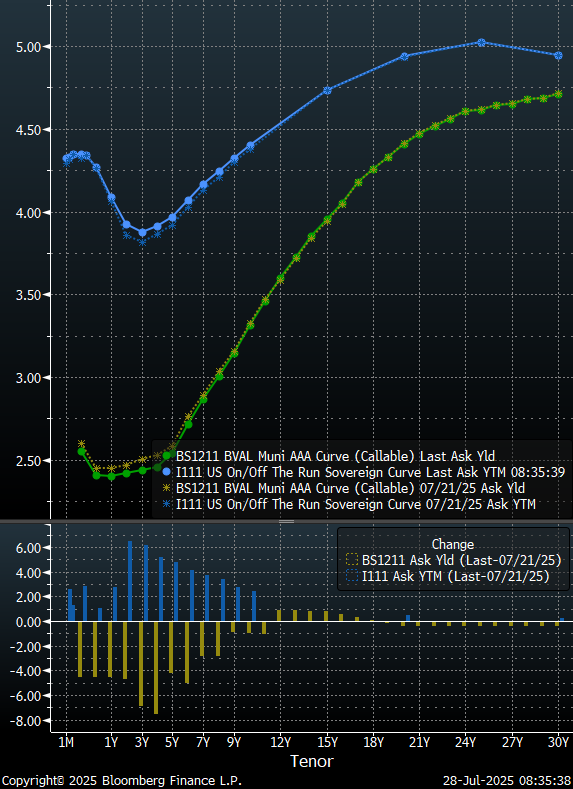
Strategy and Insights
Municipal bonds outperformed Treasuries over the past week with both munis and Treasuries experiencing their largest moves in the 1 to 5-year portion of the yield curve, although in opposite directions. While munis rallied by as much as 7.5 basis points in the 4-year tenor, Treasuries sold-off by as much as 6.7 basis points in the 2-year tenor, flattening the overall Treasury curve. Maturities past 10-years are essentially unchanged for both curves. Muni investor sentiment continues to carry a cautious tone as investors target maturities under 5-years in an effort to shorten duration on bond portfolios amid uncertainty regarding future rates.
This divergence between munis and Treasuries has resulted in richer ratios on the front end, with the 5-year tenor falling to just over 65% and the 1-year ratio dropping below 60%. Ratios on the longer-end have cheapened with the biggest changes around the 20-year tenor, which is presently over 90%. Slopes along the municipal curve continue to steepen significantly past 5-years, with an overall slope of over 100 basis points from 6 to 12-years. The 20-year portion of the curve remains appealing on a relative value basis, with yields over 90% of equivalent Treasuries and almost 95% of the entire 30-year municipal curve. However, past this point the yield curve discourages extension by flattening to just a basis point or two per year.

In addition to the Fed announcement, the economic calendar is rather hefty this week with announcements expected for housing from Case-Shiller, JOLTS job openings, MBA mortgage applications, ADP employment change and PCE. We also have a hefty bond calendar, particularly for a Fed week, which includes approximately $12 billion in new supply. Notably, the Public Finance Authority is selling $3.5 billion in senior lien toll revenue bonds to fund the Georgia SR 400 Express Lanes Project. The Fed meeting combined with economic data and the expiration of the pause on tariffs will likely test demand.
Herbert J. Sims & Co. Inc. is a SEC registered broker-dealer, a member of FINRA, SIPC. The information contained herein has been prepared based upon publicly available sources believed to be reliable; however, HJ Sims does not warrant its completeness or accuracy and no independent verification has been made as to its accuracy or completeness. The information contained has been prepared and is distributed solely for informational purposes and is not a solicitation or an offer to buy or sell any security or instrument or to participate in any trading or investment strategy, and is subject to change without notice. All investments include risks. Nothing in this message or report constitutes or should be construed to be accounting, tax, investment or legal advice.
Market Commentary: The Ivory Tower and The Street
Our team of market analysts have a singular mission: to help you make better investment decisions. Read the latest market commentary.
Continue readingCurve Commentary: July 21, 2025
Overview
Treasuries outperformed munis during this past week, as both markets moved in opposite directions on the long-end. Although uncertainty remains high, comments from Fed governor Waller supporting a July rate cut have put downward pressure on Treasury rates while the muni market struggles with: weakening fund demand, heavy supply and growing secondary offerings, particularly for maturities beyond the 10-year tenor. Looking at inflation expectations via inflation swaps, the market’s concerns become increasingly evident with two-year inflation swaps now over 3%, which is a level we haven’t seen since early 2023. In addition, with potentially higher tariffs being implemented on August 1, inflation anxiety is likely to be a significant factor this week.
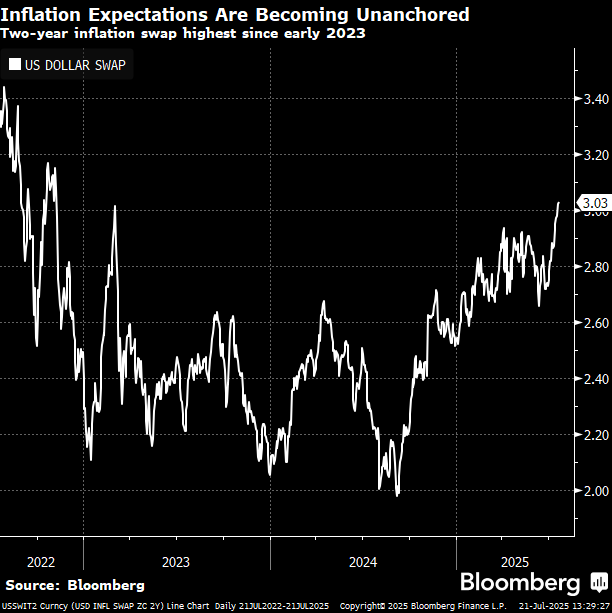
Over the past week, Treasury yields past 10-years have generally declined by approximately 5 basis points while shorter Treasury yields survived the week essentially unchanged, resulting in a flatter Treasury curve. The municipal yield curve, on the other hand, moved higher with continued strong issuance and diminishing institutional demand paving a path to higher yields by approximately 15 to 23 basis points for tenors past 10-years. Looking at the 2s10s spread, which is the difference between the 10-year yield and the 2-year yield as an indicator of the steepness of the yield curve, the municipal curve has recently reached the steepest slope in over 2-years. This is an invitation for bond investors to extend duration.
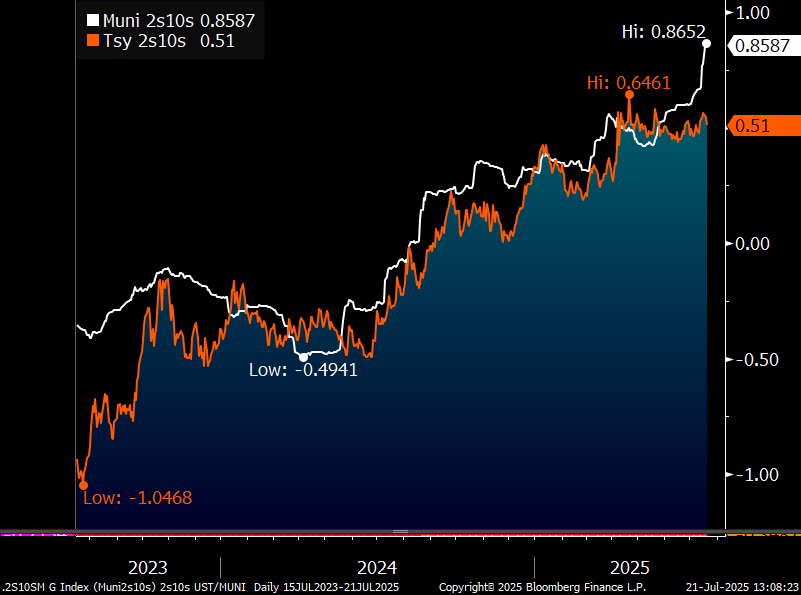
Strategy and Insights
Slopes along the municipal curve continue to steepen significantly past 5-years, with an overall slope of 92 basis points from 6 to 11-years. Although the 20-year portion of the curve remains appealing on a relative value basis, with yields at 90% of equivalent Treasuries and almost 95% of the entire 30-year municipal curve. However, past this point the yield curve discourages extension by flattening to just a basis point or two per year.
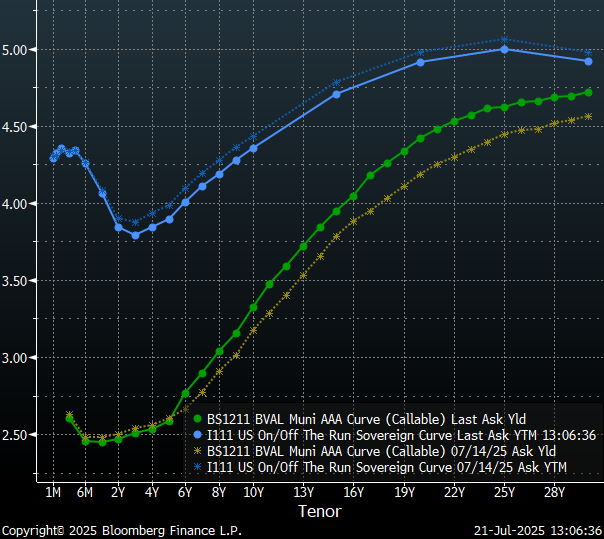
Muni/Treasury ratios have generally cheapened during this past week. Currently, 10-year munis are yielding over 75% of equivalent Treasuries and 30-year munis are yielding over 95% of equivalent Treasuries. Although ratios are rewarding extension out to the long-end of the yield curve, the slope of the curve flattens out significantly past 20-years which diminishes the reward to a traditional muni investors of duration extension.
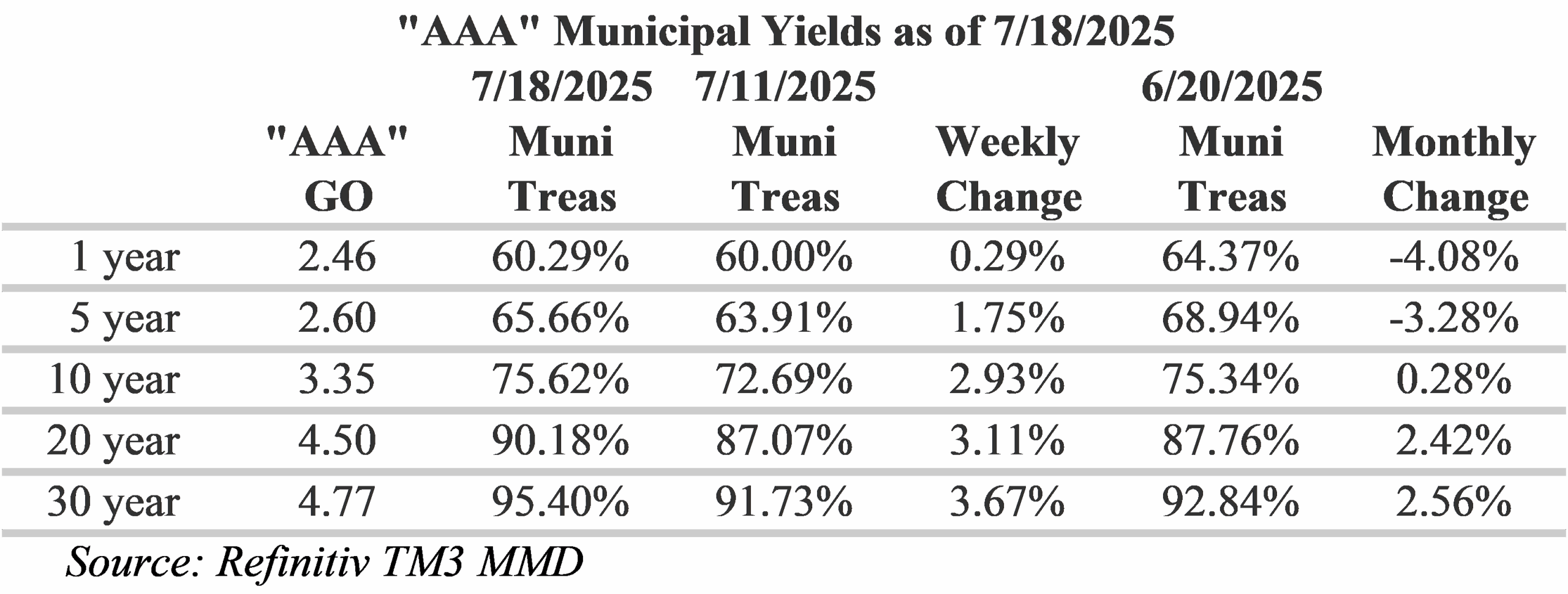
Herbert J. Sims & Co. Inc. is a SEC registered broker-dealer, a member of FINRA, SIPC. The information contained herein has been prepared based upon publicly available sources believed to be reliable; however, HJ Sims does not warrant its completeness or accuracy and no independent verification has been made as to its accuracy or completeness. The information contained has been prepared and is distributed solely for informational purposes and is not a solicitation or an offer to buy or sell any security or instrument or to participate in any trading or investment strategy, and is subject to change without notice. All investments include risks. Nothing in this message or report constitutes or should be construed to be accounting, tax, investment or legal advice.
2025 LeadingAge Michigan Leadership Institute Conference
HJ Sims is proud to be attending and speaking at the 2025 LeadingAge Michigan Leadership Institute Conference.
Speaking Details:
Lynn Daly, Executive Vice President
Date/Time:
August 6, 2025, 1:15pm-2:30pm
Topic: Senior Care Industry Trends
Start a Conversation: [email protected]
2025 Utah Charter School Network Symposium
HJ Sims is proud to be attending and sponsoring at the 2025 Utah Charter School Network Symposium.
Attendees: Robert Nickell and Akshai Patel
Start a Conversation:
Market Commentary: Open Sesame
Our team of market analysts have a singular mission: to help you make better investment decisions. Read the latest market commentary.
Continue readingCurve Commentary: July 14, 2025
Overview
Over the past week, a combination of tariff announcements, fiscal deficit anxiety and inflation concerns have driven long-term Treasury and municipal bond yields higher. Treasury yields past 10-years have generally risen by 3 to 4 basis points while shorter Treasury yields are generally 1 to 2 basis points lower, resulting in a steeper Treasury curve. The municipal yield curve exhibited a similar steepening with yields under 10-years generally 2 to 4 basis points lower and yields past 10-years generally 3 to 4 basis points higher. Looking at the 2s10s spread, which is the difference between the 10-year yield and the 2-year yield as an indicator of the steepness of the yield curve, the municipal curve has recently reached the steepest slope in over 2-years. This is an invitation for bond investors to extend duration.
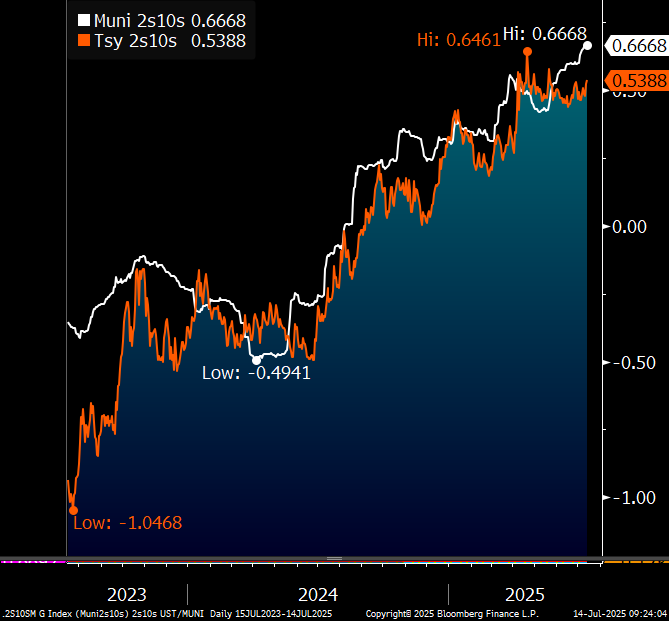
Strategy and Insights
Recently, slopes along the municipal curve have steepened significantly from 5 to 7-years, with an overall slope of 27 basis points, and remain steepest from 8 to 13-years, with an overall slope of 74 basis points. Although the 15 to 18-year portion of the curve remains appealing on a relative value basis, the overall slope is less appealing with a slope of only 45 basis points or 11.25 basis points per year. At the longer-end of the yield curve, extension is discouraged by the slope flattening to just a basis point or two per year. However, this flattening does create the opportunity for investors to pick-up 13-year maturities with yields that are 80% of the 30-year municipal yield and 18-year maturities with yields that are over 90% of the 30-year municipal yield.
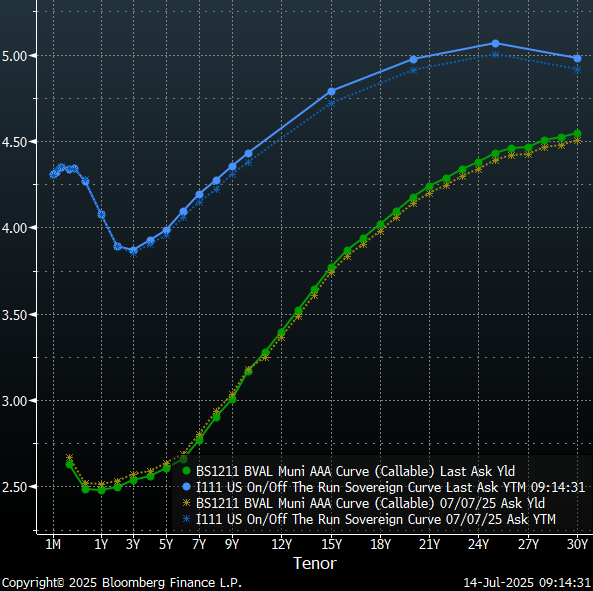
Muni/Treasury ratios have generally become less attractive over the past week. However, the longer end of the municipal curve remains appealing. Currently, 10-year munis are yielding just under 75% of equivalent Treasuries and 30-year munis are yielding around 92% of equivalent Treasuries. Although ratios are rewarding extension out to the long-end of the yield curve, the slope of the curve flattens out significantly past 20-years to just a basis point or two per year. On a relative basis, positioning around the 13-year maturity yields an intriguing combination of 75% of equivalent Treasuries and 80% of the 30-year municipal curve.
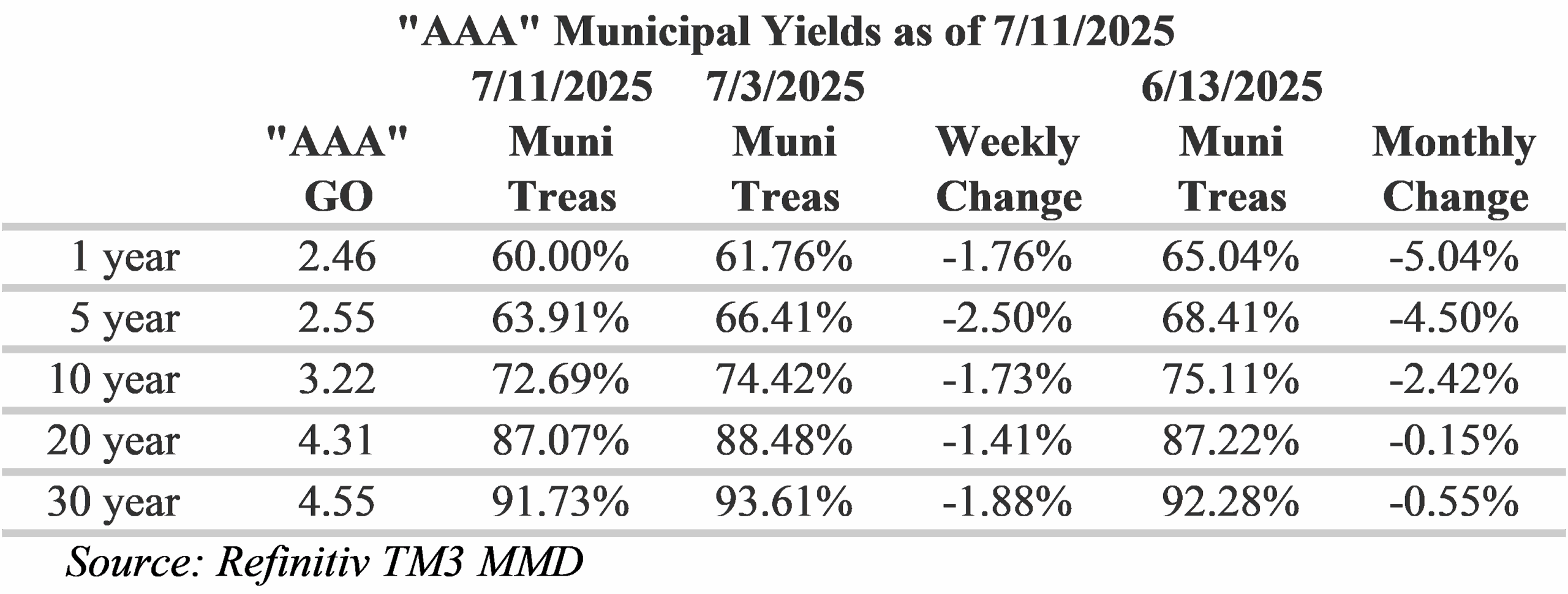
Over the week ahead, municipal issuers are expected to sell more than $14 billion of bonds with year-to-date municipal bond issuance levels eclipsing $300 billion, which is the earliest ever. Some of the larger issues on the calendar are from the California Community Choice Financing Authority, which plans to sell $1 billion in bonds, the City & County of Honolulu, which plans to sell $733.4 million, and the City of Salt Lake Utah Airport, which plans to sell $450 million. This supply will likely be met with strong demand with $23.4 billion in municipal bonds expected to mature in the next 30-days and $5.6 billion in calls announced over the next 30-days.
Herbert J. Sims & Co. Inc. is a SEC registered broker-dealer, a member of FINRA, SIPC. The information contained herein has been prepared based upon publicly available sources believed to be reliable; however, HJ Sims does not warrant its completeness or accuracy and no independent verification has been made as to its accuracy or completeness. The information contained has been prepared and is distributed solely for informational purposes and is not a solicitation or an offer to buy or sell any security or instrument or to participate in any trading or investment strategy, and is subject to change without notice. All investments include risks. Nothing in this message or report constitutes or should be construed to be accounting, tax, investment or legal advice.
Peter Becker Community (June 2025)
HJ Sims Successfully Completes
$38.9 Million Independent Living
Expansion Project with 15-Year
Bank Commitment
Market Commentary: Big Time
Our team of market analysts have a singular mission: to help you make better investment decisions. Read the latest market commentary.
Continue reading2025 LeadingAge SE
HJ Sims is proud to be attending, sponsoring, and exhibiting at the 2025 LeadingAge Southeast.
Come see us at booth 302!

Attendees

James Rester
Executive Vice President
214.252.8223
[email protected]
2024 Year in Review
2024 Year in Review
2025 Late Winter Conference Recap
Check out our 2025 Late Winter Conference Recap below:
Save the Date

The 23rd Annual HJ Sims Annual Conference will be held February 24th-26th, 2026 at the Marriott Sanibel Harbour Resort & Spa in Fort Myers, FL. Stay tuned for more information soon. We can’t wait to see you there!
For more information, please contact Kat Dymond.
2025 LeadingAge Ohio Annual Conference & Trade Show
HJ Sims is proud to be attending, sponsoring, exhibiting and speaking at the 2025 LeadingAge Ohio Annual Conference & Trade Show.
Attending: Lynn Daly, Executive Vice President & Jim Bodine, Executive Vice President
Come see us at booth 85.
Speaking Details:
Lynn Daly, Executive Vice President
August 28, 2025 – 8:30am – 9:45am
Topic:
Understanding Baby Boomers: A Tapestry of Needs, Aspirations and Resources.
Curve Commentary: July 7, 2025
Overview
Last week, the President signed into law his “Big Beautiful Bill,” which reportedly contains roughly $4.5 trillion in tax cuts, and protects the tax exemption for municipal bonds and private activity bonds. The Bill also creates a new category of private activity bonds for “spaceports” and includes a few additional bond-related provisions. The preservation of the tax-exemption is of critical importance to the municipal bond market.
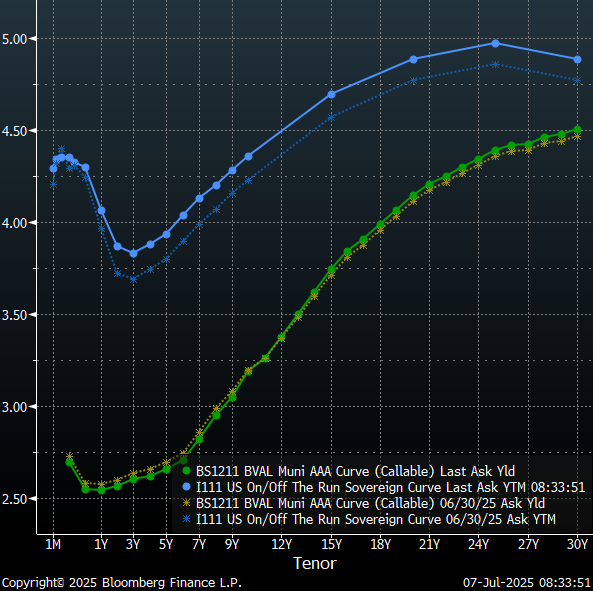
Strategy and Insights
Muni and Treasury yields moved slightly higher over this past week with the long end of the Treasury curve remaining notable steep. The municipal yield curve steepened with yields dropping roughly 3 basis points per year on the short/short-intermediate potion of the yield curve and climbing by the same magnitude on the long-end with yields pivoting around the 10-year mark. Thursday’s jobs data, released by the Bureau of Labor Statistics, dashed the markets hopes of a July rate cut with nonfarm payroll employment increasing by 147,000 jobs in June, beating the census forecast of 110,000 jobs from economists polled by Dow Jones. Furthermore, the unemployment rate fell slightly from 4.2% to 4.1%. As a result, Treasury yields generally climbed throughout the curve over the past week, with an almost parallel shift upward of 13 to 16-basis points.
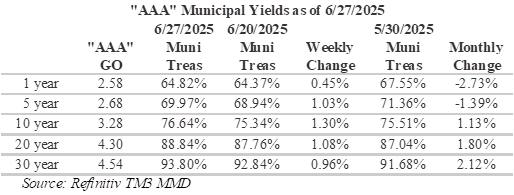
This week, municipal issuers are expected to sell more than $12.7 billion of bonds, following last week’s truncated holiday calendar. This supply will likely be met with strong demand following last week’s infusion of $958.89 million to municipal bond mutual funds, as reported by LSEG Lipper Global Fund Flows. In addition, $24.2 billion in municipal bonds are expected to mature in the next 30-days and $4.2 billion in calls have been announced over the next 30-days. Overall, technical conditions in the municipal bond market have been supportive of new issues and we expect this trend to continue.
Herbert J. Sims & Co. Inc. is a SEC registered broker-dealer, a member of FINRA, SIPC. The information contained herein has been prepared based upon publicly available sources believed to be reliable; however, HJ Sims does not warrant its completeness or accuracy and no independent verification has been made as to its accuracy or completeness. The information contained has been prepared and is distributed solely for informational purposes and is not a solicitation or an offer to buy or sell any security or instrument or to participate in any trading or investment strategy, and is subject to change without notice. All investments include risks. Nothing in this message or report constitutes or should be construed to be accounting, tax, investment or legal advice.
2025 LeadingAge SE
Attendees
Sponsor Tier 1




Sponsor Tier 2


Sponsor Tier 3

2024 Year in Review
Check out our 2024 Year in Review below:
2025 Late Winter Conference Recap
Check out our 2025 Late Winter Conference Recap below:
Save the Date

The 23rd Annual HJ Sims Annual Conference will be held February 24th-26th, 2026 at the Marriott Sanibel Harbour Resort & Spa in Fort Myers, FL. Stay tuned for more information soon. We can’t wait to see you there!
For more information, please contact Kat Dymond.
Curve Commentary: June 30, 2025
Overview
Treasury and municipal market yields rallied over this past week as the market fixated on the potential for the Fed to cut rates earlier than previously forecast. Sentiment was driven by dovish Fedspeak from Fed governors Bowman and Waller, first quarter GDP revisions to -0.5% and a benign May PCE report, all of which bolstered rate cut expectations. The futures market is now anticipating the Fed could cut rates as soon as September. However, Fed Chair Powell’s comments made last week to the House Financial Services Committee were clear, that the Fed is well positioned to wait citing elevated inflation and intensifying price pressures. Powell also commented that signs of weakness in the labor market would change the Fed’s stance. As a result, we may see some volatility in the capital markets following this week’s employment data releases on Tuesday and Thursday.
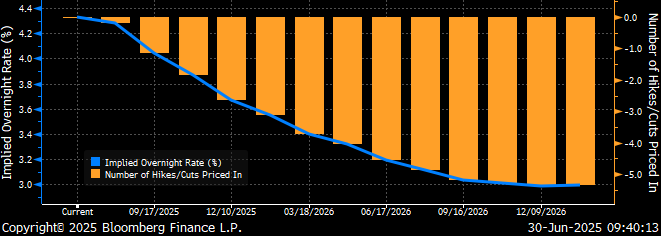
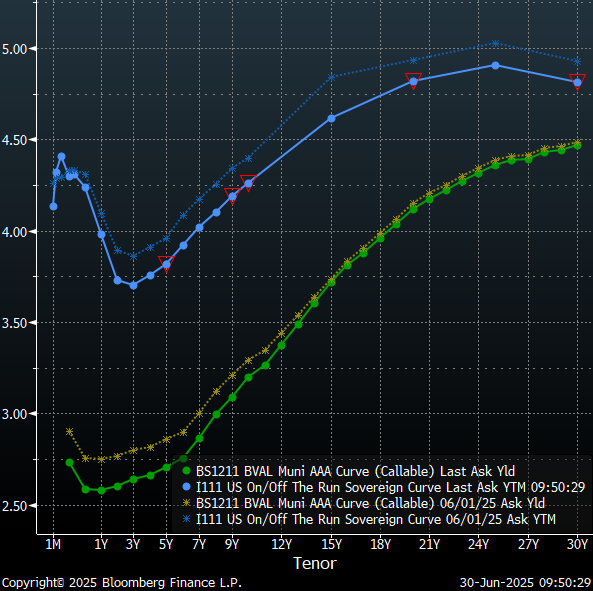
Ratios and Strategy
Over the past month, Treasury yields have rallied roughly 15-basis points from 2 to 10-years with a steeper dip of 23 basis points around the 15-year mark. While municipal yields held relatively steady, with declines of approximately 10 to 15-basis points from 2 to 10-years and 1 to 2 basis points for maturities past 15-years. As a result, muni/Treasury ratios have generally become more attractive with ratios enticing investors to extend portfolio durations with significantly higher ratios on longer maturities. Currently, 10-year munis are yielding over 76% of equivalent Treasuries and 30-year munis are yielding over 93% of equivalent Treasuries. The slope of the municipal yield curve is also rewarding extension with multiple spans along the yield curve in excess of 10 basis points per year. The steepest slopes have formed around the 10-year maturity, with an overall slope of 45 basis points from 9 to 11-years. Further out the municipal yield curve, slopes remain steep from 15 to 18-years, with an overall slope of 45 basis points. Slopes after this point taper off dramatically to just a basis point or two on the extreme long-end. The flattening on the longer-end of the yield curve allows investors to buy 17-year maturities with yields that are 90% of the 30-year municipal maturity.

Although municipal bond mutual fund flows have been steadily weakening, supply/demand technical conditions remain strong with nine consecutive weeks of positive fund flows and investors anticipating $45 billion of interest payments, maturing and called principal this week. LSEG Lipper Global Fund Flows reported municipal bond mutual funds saw an additional $76.9 million from investors. The majority of the inflows were directed to high-yield funds, which registered an additional $45.4 million compared to the previous week’s $57.7 million. This week, the calendar has contracted to $5.78 billion, which is relatively heavy for a holiday week with an early close. This past June is anticipated to be the largest June on-record for issuance and year-to-date, municipal issuance has already reached $277.8 billion, which is 17.8% ahead of last -year at this time.
Herbert J. Sims & Co. Inc. is a SEC registered broker-dealer, a member of FINRA, SIPC. The information contained herein has been prepared based upon publicly available sources believed to be reliable; however, HJ Sims does not warrant its completeness or accuracy and no independent verification has been made as to its accuracy or completeness. The information contained has been prepared and is distributed solely for informational purposes and is not a solicitation or an offer to buy or sell any security or instrument or to participate in any trading or investment strategy, and is subject to change without notice. All investments include risks. Nothing in this message or report constitutes or should be construed to be accounting, tax, investment or legal advice.
Market Commentary: The Hammer Drops
Our team of market analysts have a singular mission: to help you make better investment decisions. Read the latest market commentary.
Continue readingCurve Commentary: June 23, 2025
Overview
Although last week was a holiday week, there was a steady stream of potentially impactful headlines ranging from escalating tensions in the Middle East to an FOMC meeting. Although Fed officials left interest rates unchanged at last week’s meeting, the conflict in the middle east has disrupted air traffic, rattled global markets, and raised concerns of oil prices and inflation. However, Treasury bond yields generally slid last week amid elevated recession concerns following a disappointing release of data by the Census Bureau indicating retail sales dropped by 0.9% in May, significantly below the 0.6% contraction previously estimated by economists surveyed by Dow Jones.
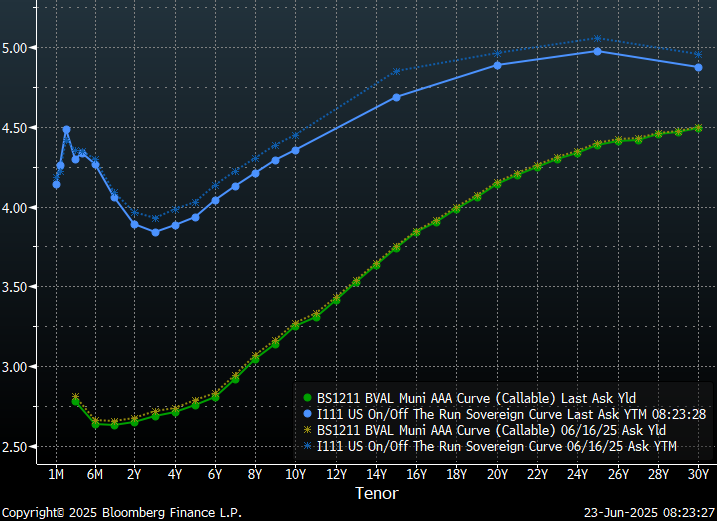
Ratios and Strategy
Over the past week, Treasury yields slid roughly 10-basis points from 5 to 30-years with a steeper dip of 20 basis points around the 15-year mark. While municipal yields held relatively steady with declines of approximately 3 basis points for maturities within 10-years and only a basis point a year on longer tenors. As a result, muni/Treasury ratios have generally become more attractive with ratios enticing investors to extend portfolio durations with significantly higher ratios on longer maturities. Currently, 10-year munis are yielding over 75% of equivalent Treasuries and 30-year munis are yielding almost 93% of equivalent Treasuries. The slope of the municipal yield curve is also rewarding extension with multiple spans along the yield curve in excess of 10 basis points per year. The steepest slopes have formed around the 10-year maturity, with an overall slope of 43 basis points from 9 to 11-years. Further out the municipal yield curve, slopes remain steep from 15 to 18-years, with an overall slope of 45 basis points. Slopes after this point taper off dramatically to just a basis point or two on the extreme long-end. The flattening on the longer-end of the yield curve allows investors to buy 17-year maturities with yields that are 90% of 30-year maturities.

Secondary trading volumes slowed last week as attentions were divided by the short week. However, municipal market technicals remain accommodative, with last week’s approximately $6 billion municipal calendar was taken down with relative ease amid $32 billion in bonds maturing over the next 30-days and an additional $7.5 billion in announced bond calls. LSEG Lipper Global Fund Flows reported municipal bond mutual funds experienced their eighth consecutive week of inflows, albeit with a modest $110.5 million being added to the asset class. High-yield funds saw an additional $57.7 million compared to the previous week’s $138 million. This week, the calendar has expanded to $11.8 billion in new issues to close-out June as one of the highest supply months seen in recent years. Year-to-date, municipal issuance has reached $265 billion, which is 19.4% ahead of last -year at this time.

Herbert J. Sims & Co. Inc. is a SEC registered broker-dealer, a member of FINRA, SIPC. The information contained herein has been prepared based upon publicly available sources believed to be reliable; however, HJ Sims does not warrant its completeness or accuracy and no independent verification has been made as to its accuracy or completeness. The information contained has been prepared and is distributed solely for informational purposes and is not a solicitation or an offer to buy or sell any security or instrument or to participate in any trading or investment strategy, and is subject to change without notice. All investments include risks. Nothing in this message or report constitutes or should be construed to be accounting, tax, investment or legal advice.
Market Commentary: Secret Spaces
Our team of market analysts have a singular mission: to help you make better investment decisions. Read the latest market commentary.
Continue readingCurve Commentary: June 16, 2025
Overview
From the perspective of the trade desk, last week was another challenging week with attentions focused on new deals rather than the secondary market. Both municipal and Treasury markets responded to last week’s reports of slower growth and lower inflation with yields dropping approximately three to six basis points across both curves. However, this week escalating overseas tensions in Israel and Iran are placing upward pressure on yields. Not surprisingly, both Brent and West Texas Intermediate crude oil prices have risen above $70 per barrel sparking concerns of inflation among traders and placing additional upward pressure on long-term yields. These concerns are in addition to the existing inflationary concerns related to the trade wars, spiraling U.S. debt concerns and traders demanding a higher premium for the risk of lending to governments following Moody’s downgrade of the United States credit rating to ‘Aa1.’ Overall, the yield gap between 10 and 30-year Treasuries has reached the widest levels we have seen since 2021.
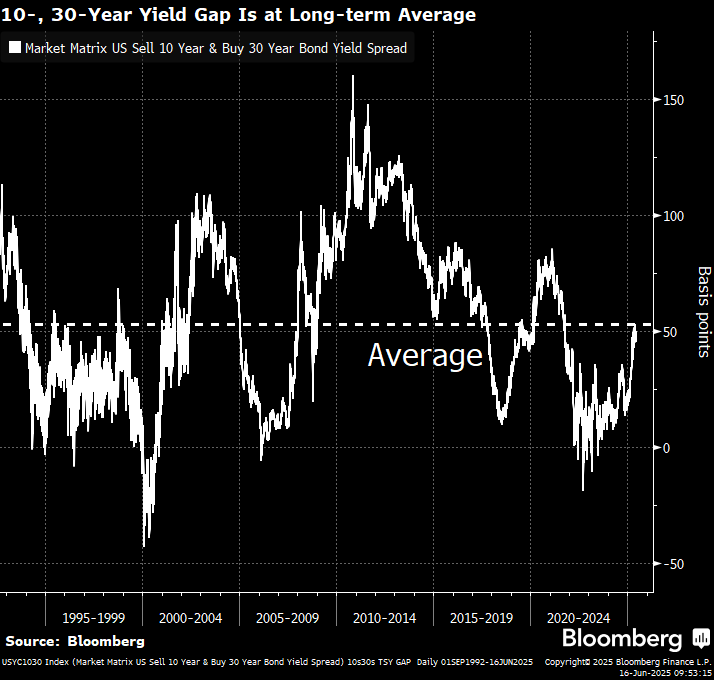
Over the past week, attentions on the trade desk have been more focused on the short-end of the curve as accounts look for safety amid global conflict, economic and policy uncertainties. The municipal curve has responded with steeper slopes in the longer-intermediate tenors with extension risk being rewarded from 2034 all the way out to 2043 with a collective 116 basis points of slope over the 10-year period. The 2036 maturity now offers over 75% of the 30-year municipal maturity and over 75% of equivalent Treasury yields. Going out an additional 6 years to 2042 nets an additional 64 basis points of yield, or 90% of the 30-year municipal maturity, and 83% of equivalent Treasury yields. Slopes on the long-end of the municipal curve taper significantly past 20-years with only a basis point or two of slope on the long-end.
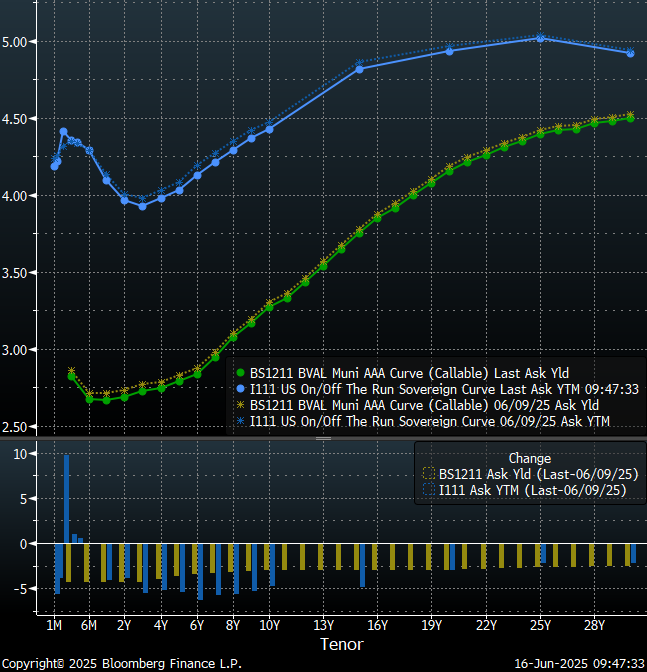
Ratios and Strategy
Muni/Treasury ratios have been relatively balanced over the past week declining on the short-end and increasing on the long-end with the largest changes in the intermediate portion of the curve around 10-years. Long-term ratios remain appealing, with 20-year munis yielding 87.22% of Treasuries and 30-year munis yielding 92.28% of Treasuries. Over the past week, we have seen ratios drop down to 65% in the 1-year tenor as investors migrate toward the safety afforded by the shorter end of the yield curve.
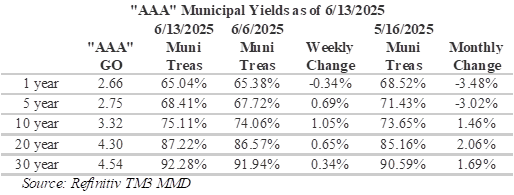
Ahead of the upcoming FOMC meeting and the Juneteenth holiday, the municipal market is anticipating a slower week as issuers are scheduled to bring $5.73 billion in new deals to market versus $17 billion last week. Market technicals remain receptive to strong issuance with LSEG Lipper Global Fund Flows reporting municipal bond mutual funds saw a seventh consecutive week of inflows with $523 million being added to the asset class following $426 million of inflows the prior week. Long-term muni funds added $72 million while high-yield funds saw an additional $138 million and intermediate funds added $35 million. In addition, $35.4 billion in municipal bonds are maturing over the next 30-days and an additional $7.8 billion of bond calls has been announced.
Herbert J. Sims & Co. Inc. is a SEC registered broker-dealer, a member of FINRA, SIPC. The information contained herein has been prepared based upon publicly available sources believed to be reliable; however, HJ Sims does not warrant its completeness or accuracy and no independent verification has been made as to its accuracy or completeness. The information contained has been prepared and is distributed solely for informational purposes and is not a solicitation or an offer to buy or sell any security or instrument or to participate in any trading or investment strategy, and is subject to change without notice. All investments include risks. Nothing in this message or report constitutes or should be construed to be accounting, tax, investment or legal advice.
Market Commentary: The Daily Soaps
Our team of market analysts have a singular mission: to help you make better investment decisions. Read the latest market commentary.
Continue reading













